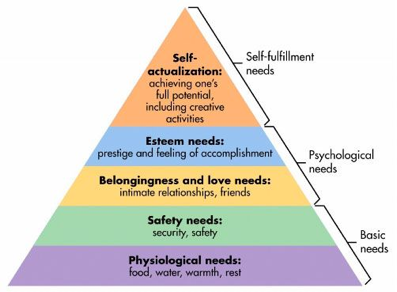Motivation in Project Management from the Project Manager’s Perspective
Overview
It is widely believed that motivated employees increase productivity. To some extend it is the project managers job to be the motivator.
According to the businessdictionary[1]: Internal and external factors that stimulate desire and energy in people to be continually interested and committed to a job, role or subject, or to make an effort to attain a goal.
There are several ways of motivating your group members, It is here presented some of the actions the project manager can take into account when motivating his group.
Maslows Hierarchy of needs
One of the theories not getting around when discussing motivation is Maslows hieararchy of needs. Every member of your team has a need, something he wants. The promise of fulfillment of the needs is what drives us. Maslow's hierarchy of needs is a theory is a five-stage model that show what needs that drives us, in which order to achieve satisfaction starting from basic needs to fulfilling the human potential(self-actualization). The first, the most basic need is the physiological needs. Lunch program at work could fufill this need, or apples in a basket. The second need is the safety needs. Make sure the team members feel safe. This could be fulfill with clear communication so the employee never feel he is unsecure if he is doing his work right, he can depand on the others in team, and so on. The third step is belongingness, and love needs. At this step the group activities is an example of fulfillment of this need. Teambuilding exercises or social events are some of the activities that can fulfill this need. The fourth step is esteem needs. When a group member excel in the project, a job gets done, it is important to acknowledge the work he has done. This could be done by giving the employees a higher position, giving a bonus, but also a small thing as a ‘good job’ can satisfy this need. With the four other needs fulfilled the team member can now reach the highest need, self-actualization and there are feelings of joy and euphoria. This step he has to reach himself.
1. Create a desire and need to fufill the project
Participation in decision-making can satisfy employees‟ self-actualization needs and, by doing so, increase employees‟ motivation and job performance (Likert, 1961)
When planning the project it is important for the manager to have planning workshops with the team. It is important that he here is the facilitator, and is open to suggestions. This will create ownership to the participants which will give incentive to do their best in the project.
During the project it is also important to communicate further down when stakeholders, timeschedule etc. change. The communication to team has to be precise, and with a RACI (Responsible, Accountable, Consulted, Informed) matrix for instace
1.1 RACI matrix
The RACI matrix illustrate every single task’s goal and the required action from each team member. It helps every person in the team to be on the same page, remove any confussion and is therefore a contribution to the motivation. The problems with the RACI model is that it does not work in dysfunctional teams. If the team already has a poor moral, this tool could feel like a whip that bury the moral even more. [3]
Reward when goals are fulfilled
When goals are fulfilled they must be rewarded. According to Maslow’s hiearchy of ne
.
Protect the team from external forces
Conlusion
References
In a given project there are several
[1]Read more: http://www.businessdictionary.com/definition/motivation.html [2] Komal Khalid Bhatti and Tahir Masood Qureshi, (2007), Impact Of Employee Participation On Job Satisfaction, Employee Commitment And Employee Productivity, International Review of Business Research Papers Vol.3 No.2 June 2007, Pp. 54 - 68
[3] https://www.teamgantt.com/blog/3-project-management-tips-on-how-to-motivate-your-team/ accessed 30.11.2014
Figure 2 http://www.cardinalsolutions.com/~/media/Images/cardinal/blog/RACI1.png?la=en
figure 1
